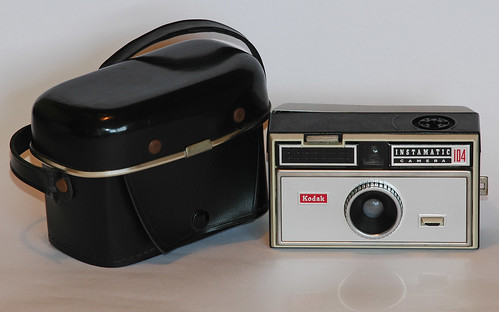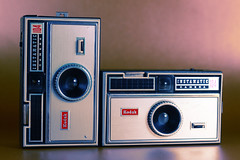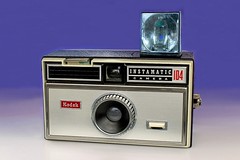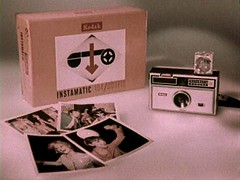Difference between revisions of "Kodak Instamatic 104"
m (General overhaul of entire page.) |
|||
| Line 1: | Line 1: | ||
{{Flickr_image | {{Flickr_image | ||
| − | |image_source= http://www.flickr.com/photos/ | + | |image_source= http://www.flickr.com/photos/holguin/410671094/in/pool-camerapedia/ |
| − | |image= http:// | + | |image= http://farm1.static.flickr.com/156/410671094_e8231906ef.jpg |
| − | |image_align= | + | |image_align= center |
| − | |image_text= <small>image by | + | |image_text= <small>image by capitan-patata</small> |
| − | }} | + | }} |
| + | <br clear="all"> | ||
Kodak's greatest success in camera history was the [[Instamatic|Instamatic camera series]] for its [[126 film]] cartridge. Sixty million such cameras were sold by Kodak alone, mostly in the 1960s and 1970s. And of course the simplest models of the series were probably the ones which boosted [[Kodak]]'s sales statistics the most. The 104 featured a connector for the new [[flashcube]], instead of the [[Kodak Instamatic 100|Instamatic 100]]'s holder for single [[flashbulbs]]. When cocked for the next exposure, the camera turns the flashcube 90 degrees to bring the next flashbulb into position. The cube can be detached by pressing the button on the front of the camera. | Kodak's greatest success in camera history was the [[Instamatic|Instamatic camera series]] for its [[126 film]] cartridge. Sixty million such cameras were sold by Kodak alone, mostly in the 1960s and 1970s. And of course the simplest models of the series were probably the ones which boosted [[Kodak]]'s sales statistics the most. The 104 featured a connector for the new [[flashcube]], instead of the [[Kodak Instamatic 100|Instamatic 100]]'s holder for single [[flashbulbs]]. When cocked for the next exposure, the camera turns the flashcube 90 degrees to bring the next flashbulb into position. The cube can be detached by pressing the button on the front of the camera. | ||
| Line 10: | Line 11: | ||
The camera was produced by [[Kodak|Eastman Kodak Co]]. in the U.S., and also by Kodak's overseas plants, for example [[Kodak AG]] in Germany, [[Kodak Ltd.]] in England, and even by a Kodak plant in Australia. | The camera was produced by [[Kodak|Eastman Kodak Co]]. in the U.S., and also by Kodak's overseas plants, for example [[Kodak AG]] in Germany, [[Kodak Ltd.]] in England, and even by a Kodak plant in Australia. | ||
| + | == Specifications == | ||
{{Flickr_image | {{Flickr_image | ||
| − | |image_source= http://www.flickr.com/photos/ | + | |image_source= http://www.flickr.com/photos/adamframe/4335051477/in/pool-camerapedia |
| − | |image= http:// | + | |image= http://farm3.static.flickr.com/2754/4335051477_3c6cd3ccbe_m.jpg |
|image_align= right | |image_align= right | ||
| − | |image_text= <small>image by | + | |image_text= <small>image by EFF ^_^</small> |
}} | }} | ||
| − | |||
*Type: [[viewfinder camera|viewfinder film camera]] | *Type: [[viewfinder camera|viewfinder film camera]] | ||
*Manufacturer: [[Kodak]] | *Manufacturer: [[Kodak]] | ||
| Line 25: | Line 26: | ||
*Shutter: mechanical leaf, with speeds of 1/90 sec. and (with flashcube attached) 1/40 sec. | *Shutter: mechanical leaf, with speeds of 1/90 sec. and (with flashcube attached) 1/40 sec. | ||
*Price: $15.95 | *Price: $15.95 | ||
| + | <br clear="all"> | ||
| + | |||
| + | == Gallery == | ||
| + | {{Flickr_image | ||
| + | |image_source= http://www.flickr.com/photos/49656291@N00/4338037416/in/set-72157620702048258/ | ||
| + | |image= http://farm5.static.flickr.com/4040/4338037416_3f5002fe09_m.jpg | ||
| + | |image_align= left | ||
| + | |image_text= With flashcube attached <br> <small>by Kenneth Dwain Harrelson</small> | ||
| + | }} | ||
| + | {{Flickr_image | ||
| + | |image_source= http://www.flickr.com/photos/49656291@N00/4340464479/in/set-72157620702048258/ | ||
| + | |image= http://farm5.static.flickr.com/4005/4340464479_f6662aec88_m.jpg | ||
| + | |image_align= | ||
| + | |image_text= <small>by Kenneth Dwain Harrelson</small> | ||
| + | }} | ||
| + | <br clear="all"> | ||
| − | + | == Links == | |
*[http://www.pbase.com/cameras/kodak/instamatic_104 camera and sample images] | *[http://www.pbase.com/cameras/kodak/instamatic_104 camera and sample images] | ||
*[http://www.collection-appareils.fr/kodak/html/insta104.php Camera] and [http://www.collection-appareils.fr/album_notices_I_K/Kodak_104/index.html User manual] on [http://www.collection-appareils.fr/general/html/francais.php www.collection-appareils.fr] by Sylvain Halgand | *[http://www.collection-appareils.fr/kodak/html/insta104.php Camera] and [http://www.collection-appareils.fr/album_notices_I_K/Kodak_104/index.html User manual] on [http://www.collection-appareils.fr/general/html/francais.php www.collection-appareils.fr] by Sylvain Halgand | ||
| Line 35: | Line 52: | ||
[[Category:Kodak AG|Instamatic 104]] | [[Category:Kodak AG|Instamatic 104]] | ||
[[Category:Australia]] | [[Category:Australia]] | ||
| − | [[Category: | + | [[Category:K]] |
[[Category:US-American 126 film]] | [[Category:US-American 126 film]] | ||
Revision as of 05:25, 9 February 2011

|
| image by capitan-patata |
Kodak's greatest success in camera history was the Instamatic camera series for its 126 film cartridge. Sixty million such cameras were sold by Kodak alone, mostly in the 1960s and 1970s. And of course the simplest models of the series were probably the ones which boosted Kodak's sales statistics the most. The 104 featured a connector for the new flashcube, instead of the Instamatic 100's holder for single flashbulbs. When cocked for the next exposure, the camera turns the flashcube 90 degrees to bring the next flashbulb into position. The cube can be detached by pressing the button on the front of the camera.
The camera was produced by Eastman Kodak Co. in the U.S., and also by Kodak's overseas plants, for example Kodak AG in Germany, Kodak Ltd. in England, and even by a Kodak plant in Australia.
Specifications

|
| image by EFF ^_^ |
- Type: viewfinder film camera
- Manufacturer: Kodak
- Year of launch: 1965
- Film: 126 film cartridge
- Lens: 1:11/43mm
- Shutter: mechanical leaf, with speeds of 1/90 sec. and (with flashcube attached) 1/40 sec.
- Price: $15.95
Gallery

|
| With flashcube attached by Kenneth Dwain Harrelson |

|
| by Kenneth Dwain Harrelson |
Links
- camera and sample images
- Camera and User manual on www.collection-appareils.fr by Sylvain Halgand